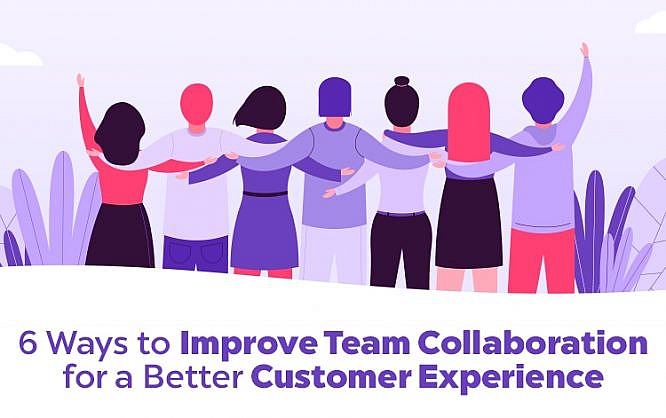6 Ways to Improve Team Collaboration for a Better Customer Experience

It was the philosopher Aristotle that said, “The whole is greater than the sum of its parts.”
He may have been speaking about how ancient cultures have worked together, but he might as well have been talking about today’s business environment. When teams work together, they can create better products than individuals.
It’s a fact: collaborative teams perform five times better. However, that only works when team members share a common goal.
For most businesses, there’s no greater goal than creating a great customer experience.
The Importance of a Great Customer Experience
In a business environment that is increasingly becoming commodity-based, companies that provide a better customer experience are differentiating themselves from their competitors. 73% of companies that score above-average on customer experience surveys perform better than their competitors. This gap between companies that provide great customer experience and those that don’t is big. Brands with superior customer service and customer experience scores earn 5.7 times more revenue.
So, what does this mean? In short, one of the business’s biggest goals should be to strive for impeccable customer service. For this to work, however, employees and team members need to share this goal as well.
Improving Collaboration in the Workplace
It’s not enough to simply tell employees to work as a team. Companies have to provide the proper framework and business incentives to make it happen.
Start by providing the right tools and the right workflow. This is often different for every business. It’s wise to take some time to observe where improvements could be made and how the teams seem to work best. From there, create a workflow and set expectations for employees on how to follow it.
It’s also crucial that employees have the right tools to complete their work effectively and efficiently. Evaluate where projects are getting stuck. One of the simplest ways to find out what tools an employee is lacking is to simply ask them!
Workflow
A clearly defined – and simple – workflow is crucial to fostering collaboration in the workplace. At its core is a system that takes projects and breaks them down into steps or tasks, manages assignments and deadlines, tracks progress, and communicates across teams.
This workflow system acts as the central hub, or clearinghouse, for employees to stay in constant communication on projects. Team messaging software like 8x8 that trackscan track conversations, allows for uploading and file sharing, provides meetings and messaging capabilities, and allows collaboration across platforms can help manage the workflow and communication.
The Team
Collaboration works best when team members have complementary skills. This means assembling the right group of people with the skills necessary to manage the task. You wouldn’t, for example, assemble a baseball team with only a group of pitchers. You need offensive and defensive weapons in order to compete successfully.
Grow Your Team
Team chemistry plays a vital role in how teams perform. It’s important to help team members create bonds that build strong relationships. Team chemistry, the Harvard Business Review reports, is the new “holy grail” of performance analytics. In other words, the way teams interact and support each other makes a significant difference in outcomes.
Chemistry amongst a team is built of many components; some of which include personalities, built trust and working towards common goals. Consider improving these by having employees take a personality test or free MBTI assessment, create team-building exercises and events and ensure everyone is clear on shared goals.
Measure Outcomes
You can’t manage what you can’t measure. When it comes to customer experience, you need to set achievable benchmarks and then measure team performance against these benchmarks regularly. When teams accomplish goals, it improves morale and helps them understand the role they play in a company’s success.
These goals should be both short-term and long-term. For example, a short-term goal for a call center might be to improve first-call resolution or CSAT (Customer Satisfaction Survey) scores. A long-term goal might be to increase repeat business from satisfied customers.
It’s important to ensure you’re able to track these as well. For example, if you use a CRM like Dubsado or Zoho, set expectations for your teams. A manager could consider listening in on calls, live or recorded as well. You can also have your customer service team make a spreadsheet of common issues they’re hearing about via phone calls or customer service emails. Once you know where you’re starting, it makes creating realistic goals much easier.
Common Goals
When team members rally around a common goal, magic can happen in the workplace. When teams fully understand the common mission, they are more likely to work towards that mission and hold each other accountable. This creates the right atmosphere for improving the customer experience.
After tackling how to measure progress and outcomes, this is the time to start setting goals. See what is a realistic goal is for the business and how it will improve work - especially when it comes to the customer service.
Reward Success
When teams do accomplish goals, it’s time to celebrate success. There are a lot of possibilities here! Whether it’s a gift card, a day off, an office party, or perhaps a special parking spot. Great team members will be striving to reach their goals regardless, but there are few things more disheartening than having great work ignored.
It’s important for a business to show their employees that they care and that when the company is rewarded with progress, so are the teams that made it happen.
A Collaborative Approach to Customer Experience
It takes a collaborative approach to build superior customer experiences. Getting your team to work together and focus on providing that great customer experience is crucial to business success. That starts with building the right team, focusing them on common goals, providing them the right tools to collaborate, and rewarding positive outcomes.
Get out there and collaborate!
Business vector created by pikisuperstar - www.freepik.com